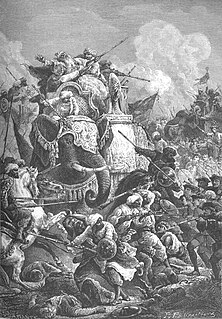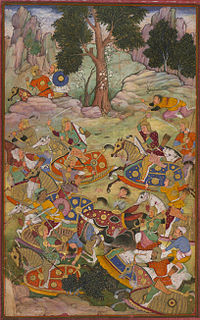 W
WThe Battle of Ambur was the first major battle of the Second Carnatic War.
 W
WThe Battle of Bhatvadi was fought in 1624, near modern Bhatodi Pargaon village in Maharashtra, India. The Ahmadnagar army led by Malik Ambar defeated a combined Mughal-Bijapur force led by the Bijapuri general Mullah Muhammad Lari.
 W
WThe Battle of Bhuchar Mori, also known as Battle of Dhrol, was fought between the army of Kathiawar led by Nawanagar State and the Mughal army at Bhuchar Mori plateau near Dhrol, Saurashtra. It was meant to protect Muzaffar Shah III, the last Sultan of Gujarat Sultanate who had taken asylum under Jam Sataji of Nawanagar after his escape from the Mughal emperor Akbar. It was fought in July 1591. The Kathiawar army included the armies of Junagadh and Kundla who betrayed Nawanagar and joined the Mughal army at last. The battle led to a large number of casualty on both sides. The battle resulted in the decisive victory of the Mughal army.
 W
WThe Battle of Haldighati was a battle fought on 18 June 1576 between cavalry and archers supporting the Rana of Mewar, Maharana Pratap, and the Mughal emperor Akbar's forces, led by Man Singh I of Amber. The Mughals were the victors and inflicted significant casualties among the Mewaris but failed to capture Pratap, who escaped.
 W
WThe Battle of Buxar was fought on 22 October 1764, between the forces under the command of the British East India Company, led by Hector Munro, and the combined armies of Mir Qasim, Nawab of Bengal till 1764; the Nawab of Awadh Shuja-ud-Daula; and the Mughal Emperor Shah Alam II accompanied by Raja Balwant Singh of Kashi. The battle was fought at Buxar, a "small fortified town" within the territory of Bihar, located on the banks of the Ganga river about 130 kilometres (81 mi) west of Patna; it was a decisive victory for the British East India Company. The war was brought to an end by the Treaty of Allahabad in 1765.
 W
WThe Battle of Chamkaur, also known as Battle of Chamkaur Sahib, was a battle fought between the Khalsa, led by Guru Gobind Singh, and the coalition forces of the Mughals led by Wazir Khan. Guru Gobind Singh makes a reference to this battle in his victory letter Zafarnama.
 W
WThe Battle of Chanderi took place in the aftermath of the Battle of Khanwa in which the Mughal Emperor Babur had defeated the Rajput Confederacy and firmly establish Mughal rule while crushing regrowing Rajput powers as The Battle was fought for supremacy of Northern India between Rajputs and Mughals. On receiving news that Rana Sanga had renewed war preparations to renew the conflict with him, Babur decided to isolate the Rana by inflicting a military defeat on one of his Vassals Medini Rai who was the ruler of Malwa. Consequently, in December 1527, taking a circumlocutious route Babur marched to the fortress of Chanderi in Malwa which was Capital of Medini Rai kingdom Malwa. Upon reaching Chanderi, on 20 January 1528, Babur offered Shamsabad to Medini Rao in exchange for Chanderi as a peace overture and also Chanderi was of great importance in Conquering Malwa but the offer was rejected by Rao.
 W
WThe Battle of Chappar Chiri was fought between Mughal Empire and the Sikhs in May 1710.
 W
WThe Battle of Karnal, was a decisive victory for Nader Shah, the founder of the Afsharid dynasty of Persia, during his invasion of India. Nader's forces defeated the army of Muhammad Shah within three hours, paving the way for the Persian sack of Delhi. The engagement is considered the crowning jewel in Nader's military career as well as a tactical masterpiece. The battle took place near Karnal, 110 kilometres (68 mi) north of Delhi, India.
 W
WThe battle of Khyber Pass was an engagement fought in the mid-eighteenth century between the Persian empire of Nader Shah and the Mughal vassal state of Peshawar. The result was an overwhelming victory for the Persians opening up the path ahead to invade the crown-lands of the Mughal empire of Muhammad Shah.
 W
WBattle of Khajwa (Khajuha) was a battle fought on January 5, 1659, between the newly crowned Mughal Emperor Aurangzeb and Shah Shuja who also declared himself Mughal Emperor in Bengal. Shuja's army rested by the tank of Khajwa, about 30 miles to the west of Fatehpur- Haswa in'the Allahabad District, between the Ganges and the Jumna.
 W
WThe Battle of Khanwa was fought near the village of Khanwa, in Bharatpur District of Rajasthan, on March 16, 1527. It was fought between the invading forces of the first Mughal Emperor Babur and the Rajput forces led by Rana Sanga of Mewar, after the Battle of Panipat. The victory in the battle consolidated the new Mughal dynasty in India.
 W
WThe Mughal–Safavid War of 1622–1623 was fought over the important fortress city of Kandahar, in Afghanistan, between the Safavid empire and the Mughal empire.
 W
WEmperor Nader Shah, the Shah of Persia (1736–47) and the founder of the Afsharid dynasty of Persia, invaded Northern India, eventually attacking Delhi in March 1739. His army had easily defeated the Mughals at the battle at Karnal and would eventually capture the Mughal capital in the aftermath of the battle.
 W
WThe Sindh Expedition was one of Nader Shah's last campaigns during his war in northern India. After his victory over Muhammad Shah, the Mughal Emperor, Nader had compelled him to cede all the lands to the west of the Indus river. His return to this region from Delhi was honoured by all the governors of the newly annexed territories save for Khodayar-khan, ruler of Sindh, who was conspicuously absent despite being given a summons like the rest of the governors.
 W
WThe Third Battle of Panipat took place on 14 January 1761 at Panipat, about 97 km north of Delhi, between the Maratha Empire and the invading Afghan army of, supported by three Indian allies—the Rohilla (Najib-ud-daulah), Afghans of the Doab region, and Shuja-ud-Daula. The Maratha army was led by Sadashivrao Bhau who was third in authority after the Chhatrapati and the Peshwa. The main Maratha army was stationed in Deccan with the Peshwa. Militarily, the battle pitted the artillery and cavalry of the Marathas against the heavy cavalry and mounted artillery of the Afghans and Rohillas led by Abdali and Najib-ud-Daulah, both ethnic Afghans. The battle is considered one of the largest and most eventful fought in the 18th century, and it has perhaps the largest number of fatalities in a single day reported in a classic formation battle between two armies.
 W
WThe First Battle of Panipat, on 21 April 1526, was fought between the invading forces of Babur and the Lodi dynasty. It took place in north India and marked the beginning of the Mughal Empire and the end of the Delhi Sultanate. This was one of the earliest battles involving gunpowder firearms and field artillery in the Indian subcontinent which were introduced by Mughals in this battle.
 W
WThe Second Battle of Panipat was fought on 5 November 1556, between the Hindu emperor of north India, Hemu, and the forces of the Mughal emperor Akbar. Hemu had conquered the states of Delhi and Agra a few weeks earlier by defeating the Mughals led by Tardi Beg Khan at the Battle of Delhi and proclaimed himself Raja Vikramaditya at a coronation in Purana Quila in Delhi. Akbar and his guardian Bairam Khan who, after learning of the loss of Agra and Delhi, marched to Panipat to reclaim the lost territories. The two armies clashed at Panipat not far from the site of the First Battle of Panipat of 1526.
 W
WBattle of Samugarh, Jang-e-Samugarh,, was a decisive battle in the struggle for the throne during the Mughal war of succession (1658–1659) between the sons of the Mughal Emperor Shah Jahan after the emperor's serious illness in September 1657. The battle of Samugarh was fought between his sons Dara Shikoh and his two younger brothers Aurangzeb and Murad Baksh.
 W
WThe Battle of Saraighat was a naval battle fought in 1671 between the Mughal Empire, and the Ahom Kingdom on the Brahmaputra river at Saraighat, now in Guwahati, Assam, India. Although weaker, the Ahom Army defeated the Mughal Army by brilliant uses of the terrain, clever diplomatic negotiations to buy time, guerrilla tactics, psychological warfare, military intelligence and by exploiting the sole weakness of the Mughal forces—its navy.
 W
WThe Siege of Bijapur began in March 1685 and ended in September 1686 with a Mughal victory. The siege began when the Aurangzeb dispatched his son Muhammad Azam Shah with a force of nearly 50,000 men to capture Bijapur Fort and defeat Sikandar Adil Shah, the then ruler of Bijapur who refused to be a vassal of the Mughal Empire. The Siege of Bijapur was among the longest military engagements by the Mughals, lasting more than 15 months until Aurangzeb personally arrived to organize a victory.
 W
WThe Siege of Chittorgarh was a part of the campaign of the Mughal Empire against the kingdom of Mewar in 1567. Forces led by Akbar surrounded and besieged 8,000 Rajputs and around 40,000 peasants under the command of Jaimal in Chittorgarh.
 W
WThe Siege of Golconda occurred in January 1687, when Mughal Emperor Aurangzeb led his forces to besiege the Qutb Shahi dynasty at Golconda Fort and was home to the Kollur Mine. The ruler of Golconda was the well entrenched Abul Hasan Qutb Shah. Aurangzeb and the Mughal army had successfully conquered two Muslim kingdoms: Nizamshahis of Ahmednagar and the Adilshahis of Bijapur. It was only a matter of time that the Mughal army arrived at Golconda Fort. The siege of Golconda lasted 8 months and on various occasions it had pushed the massive Mughal army to its limits, in fact the Golconda Fort was probably the most impregnable fort in the Indian subcontinent. Aurangzeb and the Mughals entered Golconda through a decisive victory.
 W
WSiege of Ranthambore, on February 8, 1568, Akbar led a massive Mughal Army composed of over 50,000 men and besieged Ranthambore Fort. Akbar had become emboldened after his victories at the Battle of Thanesar and the Siege of Chittorgarh and only Ranthambore Fort remained unconquered. Akbar believed that Ranthambore Fort was a major threat to the Mughal Empire because it housed great Hada Rajputs who considered themselves sworn enemies of the Mughals.
 W
WThe Battle of Sinhagad took place during the night on 4 February 1670 on the fort of Sinhagad, near the city of Pune, Maharashtra, India.
 W
WThe Battle of Sonipat was fought between Sikhs and Mughal Empire in 1709.
 W
WThe Sylhet uprising of 1782, also known as the Muharram Rebellion, took place in early December against the East India Company by the Bengali Muslims led by the Pirzada of Sylhet and his two brothers, Syed Muhammad Hadi and Syed Muhammad Mahdi. It was one of the first ever anti-British movement in the subcontinent. The main battle took place in the Mughal-built Sylhet Shahi Eidgah and its surrounding hills.
 W
WBattle of Thanesar, was fought on the eve of Solar eclipse holy bath fair on 9 April 1567, near Thanesar on the banks of the Sarsawati Ghaggar River in the state of Haryana. While the Mughal Emperor Akbar was on his campaign to subdue the Rajputs, he set up camp at a water Qanat and established camp around that fresh water reservoir in order to properly manage his forces in the nearby regions.
 W
WThe Battle of Tukaroi, also known as the Battle of Bajhaura or the Battle of Mughulmari, was fought between the Mughal Empire and the Bengal Sultanate on 3 March 1575 near the village of Tukaroi in present-day Balasore District of Odisha. it resulted in a Mughal victory and greatly weakened the Bengal Sultanate.